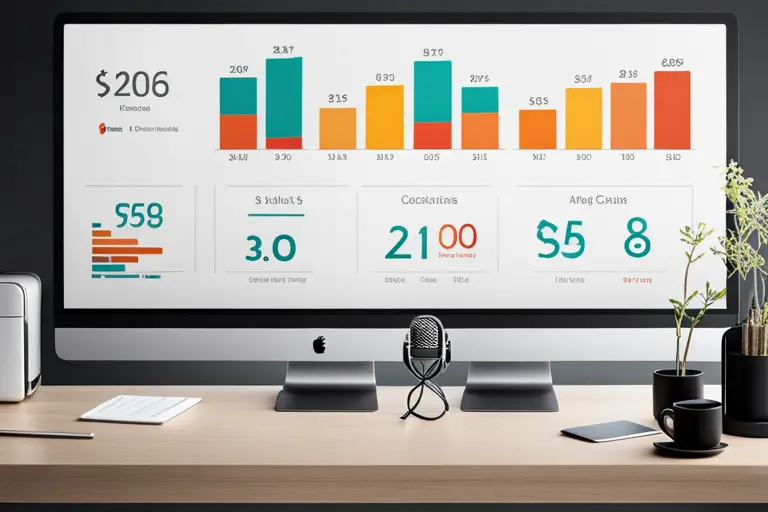When it comes to analyzing social media data, it’s essential to focus on the right metrics to gain meaningful insights. With so many social media platforms and metrics to choose from, it can be overwhelming to know where to start. However, by focusing on the top metrics that matter, you can gain a deeper understanding of your audience and improve your social media strategy.
Engagement metrics are crucial when analyzing social media data. Likes, comments, shares, and mentions are all indicators of how well your content is resonating with your audience. By measuring these metrics, you can gain insights into what type of content your audience prefers, what topics they are interested in, and how they engage with your brand.
In this article, we’ll explore the top metrics to focus on when analyzing social media data, so you can make informed decisions and improve your social media strategy.
Engagement Metrics: Likes, Comments, Shares, and Mentions
Ready to dive into the nitty-gritty of social media metrics? Let’s start by exploring the engagement metrics that truly matter – likes, comments, shares, and mentions!
These metrics are essential to track the success of your social media campaigns because they indicate how your audience is interacting with your content. Likes, comments, shares, and mentions are all forms of engagement that show how interested your audience is in your content.
Likes are a simple way for users to show they enjoyed your content, while comments offer a more in-depth form of engagement by allowing users to share their thoughts and opinions. Shares are a powerful form of engagement because they expose your content to a wider audience, while mentions show that users are actively engaging with your brand.
By tracking these engagement metrics, you can gain valuable insights into your audience’s preferences and create more engaging content that resonates with them.
Reach and Impressions Metrics
When it comes to analyzing social media, don’t overlook the importance of reach and impressions metrics. Reach is the number of unique users who’ve seen your content, while impressions refer to the total number of times your content has been displayed. These metrics are important because they show you how many people are exposed to your brand and how often they’re seeing your content.
Measuring reach and impressions can give you valuable insights into how effective your social media strategy is in terms of generating brand awareness. If your reach is low, it could mean that your targeting is off or that your content isn’t resonating with your audience. On the other hand, if your impressions are high but your engagement is low, it could mean that your content needs to be more engaging or that you need to adjust your targeting to reach a more relevant audience.
By keeping an eye on these metrics, you can make informed decisions about how to improve your social media presence.
Follower Growth and Demographics
Growing your follower count and understanding your audience’s demographics is crucial for maximizing your social media impact. Follower growth is a key metric that can help you understand how your content is resonating with your target audience. By tracking your follower count over time, you can identify trends and make adjustments to your content strategy to attract more followers.
Additionally, follower growth can be an indicator of overall brand awareness and loyalty. The more followers you have, the more potential customers you have to engage with and convert.
Understanding your audience’s demographics is another important metric to focus on. Demographic data, such as age, gender, location, and interests, can give you valuable insights into who your audience is and what they care about. By analyzing this data, you can tailor your content to better meet their needs and interests.
For example, if you find that a large portion of your audience is interested in fitness, you can create more content related to health and wellness. By catering to your audience’s preferences, you can increase engagement and build a stronger relationship with your followers.
Click-Through Rates and Conversion Metrics
It’s crucial to keep track of click-through rates and conversion metrics to determine the effectiveness of your social media content.
Click-through rate (CTR) measures the percentage of users who click on a link or call-to-action within your content, while conversion metrics track the number of users who take a desired action, such as filling out a form or making a purchase.
By analyzing these metrics, you can gauge how well your content is resonating with your audience and adjust your strategy accordingly.
To improve click-through rates, consider using attention-grabbing headlines, clear calls-to-action, and relevant imagery. It’s also important to understand your audience’s preferences and tailor your content to meet their needs.
For conversion metrics, make sure your website or landing page is optimized for conversions, with a clear and easy-to-use layout, effective copy, and prominent calls-to-action.
By focusing on these metrics, you can maximize the impact of your social media content and drive tangible results for your business.
Content Performance Metrics
To fully understand how well your content is resonating with your audience, you need to track performance metrics that can provide valuable insights and help you improve your strategy. Content performance metrics can give you a clear picture of how your content is performing across different channels and platforms.
These metrics can include engagement rates, reach, impressions, and shares. Engagement rates are a crucial metric to track as they can give you insights into how your audience is interacting with your content. This metric includes likes, comments, and shares, and it can give you an indication of how well your content is resonating with your audience.
Reach and impressions can also give you a sense of how many people are seeing your content. If your content is not reaching as many people as you would like, you may need to revisit your distribution strategy. Finally, tracking shares can give you insights into how viral your content is and can help you identify content that is resonating with your audience.
By tracking these metrics, you can make data-driven decisions to improve your content strategy and create more engaging content for your audience.
Social Listening and Sentiment Analysis
Now that you’ve learned about content performance metrics, it’s time to focus on social listening and sentiment analysis.
These metrics help you understand what your audience is saying about your brand, products, and services on social media. By analyzing social media conversations, you can gain insights into customer opinions, preferences, and pain points.
Social listening involves monitoring and analyzing social media mentions, hashtags, and keywords related to your brand. This metric helps you understand how your brand is perceived online, what topics are trending, and what your competitors are doing.
On the other hand, sentiment analysis involves analyzing the tone and emotion of social media conversations. This metric helps you identify positive, negative, or neutral sentiment towards your brand and products. By tracking sentiment over time, you can measure the effectiveness of your social media campaigns and customer service efforts.
Competitive Analysis and Benchmarking
Competitive analysis and benchmarking can provide valuable insights into your industry and help you stay ahead of the competition. By analyzing your competitors’ social media metrics, you can identify gaps in your own strategy and make necessary adjustments.
It’s important to look at metrics such as engagement rate, follower growth, and content performance to understand how your competitors are resonating with their audience and what tactics they’re using to achieve success.
Benchmarking against your competitors can also help you set realistic goals for your own social media strategy. By understanding what is achievable within your industry, you can set targets for growth and engagement that are feasible and relevant.
Additionally, competitive analysis can help you identify opportunities for differentiation and innovation. By analyzing what your competitors are doing well and where they’re falling short, you can find ways to offer something unique to your audience and stand out from the crowd.
Frequently Asked Questions
How do you measure the success of social media campaigns beyond engagement metrics?
To measure success beyond engagement metrics, you need to focus on conversions, leads, sales, and ROI. Use relevant tracking tools, set specific goals, and analyze the results to determine the effectiveness of your social media campaigns.
What are some effective strategies for increasing reach and impressions on social media?
To increase reach and impressions on social media, you can try using paid advertisements, collaborating with influencers, posting at the right time, engaging with your audience, and creating shareable content.
How do you analyze and use follower demographics to inform social media strategy?
To use follower demographics to inform your social media strategy, analyze data to identify your audience’s age, gender, location, and interests. Use this information to tailor content and target ads to maximize engagement and conversions.
What factors contribute to high click-through rates and how can they be improved?
To improve click-through rates, focus on creating compelling headlines, clear and concise messaging, and visually appealing content. Use A/B testing to determine what resonates with your audience and adjust accordingly.
How can you effectively measure the ROI of social media efforts through conversion metrics?
To measure ROI of social media efforts, focus on conversion metrics such as click-through rates, lead generation, and sales. Set specific goals, track progress, and adjust strategies accordingly. Don’t forget to factor in costs and calculate the overall ROI.
Conclusion
So, now that you’ve got a good understanding of the top metrics to focus on when analyzing social media data, it’s important to remember that these metrics aren’t the only ones that matter. It’s crucial to tailor your metrics to your specific business goals and objectives.
By regularly analyzing your social media metrics, you can gain valuable insights into your audience, content performance, and overall social media strategy. This can ultimately lead to better engagement, increased reach, and more conversions for your business.
So, don’t be afraid to experiment with different metrics and strategies to find what works best for you. Happy analyzing!

Hey there, tech enthusiasts! I’m your go-to content writer, delving into the fascinating world of technology hacks. Get ready to unlock mind-blowing secrets and discover innovative solutions through my engaging and insightful blogs.


